Asanti StoreFront 3.5 Release Notes
Version 3.5 of the Asanti StoreFront web-to-print solution will be released on June 12, 2016. The main new features are:
- PrintSphere integration — manage large image libraries using PrintSphere
- Multiple delivery addresses — users can ask to ship an order to multiple locations
- Custom user attributes — store additional data about shoppers
- Scaling policy — more controls for scaling PDF files when printing posters or billboards
- Split shipping costs — report shipping costs as a separate item to MIS systems
More information about StoreFront is available in the Online Help and the Online Help Addendum.
Existing users should check the post-update guidelines
Product & Product Templates
Scaling policy for uploadable products
When users order an uploadable product but the PDF file they upload does not have the same aspect ratio as the requested output size, StoreFront could previously rescale the PDF and potentially trim part of the content. Version 3.5 offers more refined controls to handle scaling, which is useful for posters, banners, billboards and other large-format products. In the Product Templates > Preflight menu window there are two new options:
- In the Fixes section you can define how a PDF should be rescaled. This is always done proportionally, StoreFront never distorts the PDF content. Use the Underfill option to define that the PDF should be scaled so that its entire content is visible. This might mean there is some white space either horizontally or vertically. The Overfill option makes sure the full target output size is filled with content, but part of the rescaled PDF is cropped either horizontally or vertically.
- In the Validation section a new Trim Box Tolerance setting defines how much an uploaded PDF can deviate from the target output size for it to be considered the correct size.
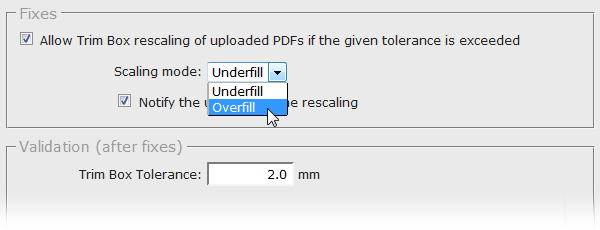
Additional preflight checks
The preflight engine can now also check if line-art and images in uploaded PDF files are properly tagged with an ICC profile.
Additional file formats
Next to PDF, TIFF, and JPEG images, users can now also upload BMP, GIF and PNG files to order an unbound uploadable product.
Online Editor
Shared image libraries
StoreFront allows you to associate an image library with specific customizable products or with all the customizable products in a store. Maintaining such image libraries could become a hassle since images have to be manually uploaded one at a time. It also wasnt possible to use subfolders to structure larger libraries.
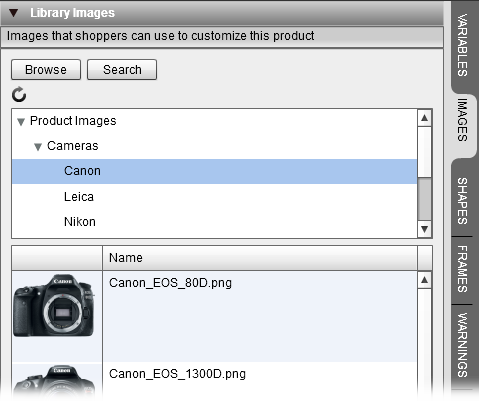
These limitations can be resolved by combining StoreFront with PrintSphere, a new hosted data sharing service of Agfa Graphics. Folders stored and managed on PrintSphere can now be used as image libraries in the Online Editor. This allows you to create subfolders, do bulk uploads or upload images using drag and drop all within a standard web browser. Since PrintSphere folders can be shared, the images libraries can also be managed by the company for which a store is set up. This gives more control to that company while freeing up time for the print service provider.
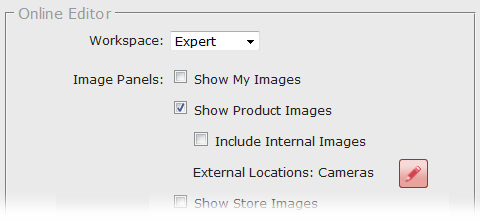
Keep in mind that images from a shared library cannot yet be used in Image variables.
Copy fitting styles
Copy fitting styles make sure the same copy fitting style percentages are applied to all of the text frames. If a user customizes a business card and enters a long address, a copy fitting style can make sure the font size of the e-mail address, company URL, and other data use the same type size. This ensures the use of consistent font sizes throughout the document.
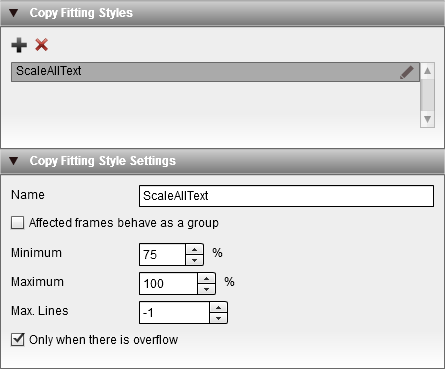
Frame anchors
When the Autogrow feature is used to change the dimensions of a frame or if an action is used to move its position, it can be useful that other frames also move at the same time. This can be done using the new anchor function. Simply tag the frame that will move or grow, select the frame that should adapt its position and define in the Objects > Anchors tab how this should happen.
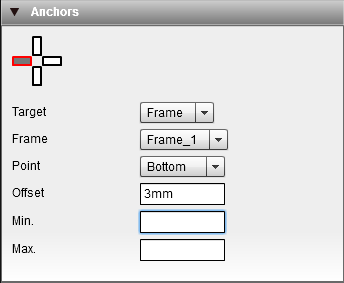
Updated InDesign CC plug-in
A new version 4.5.2.0 of the StoreFront Converter extension for Adobe InDesign 2015 Creative Cloud can be downloaded in StoreCenter. It includes some minor bug fixes and reworked installation instructions.
Ordering & Checkout
Multiple delivery addresses
A new shipping method is available, which allows shoppers to specify that they want their order to be shipped to multiple addresses.
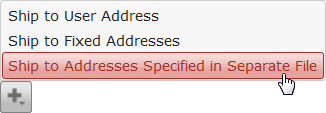
When users select this method during checkout, they are asked to attach a file containing shipping instructions to the order. The file can be any type (txt, Word, Excel, PDF, etc.) and it is expected to specify how the order should be shipped. This means that for an order of 5000 leaflets, 2000 go to one destination and the remainder to three other locations. Alternatively two items might go to one address and six others to a different one. The file can also be used to state that all items should go to one specific address, but with specific instructions for the delivery time or packaging of the goods.
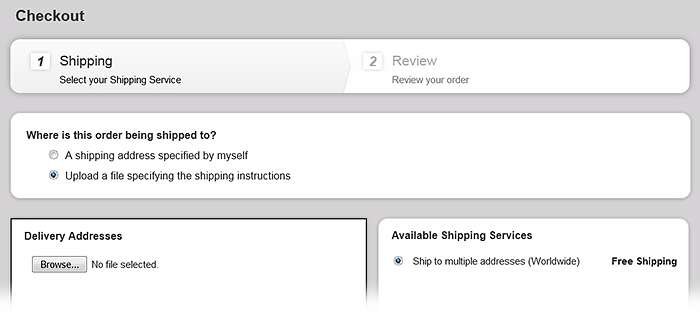
StoreFront does not validate or process the attached file in any way. This means that some ways of calculating shipping costs, such as those based on the destination, are not available. It also means data about the delivery address cannot be included in the Excel order summary or in the communication with MIS systems.In the StoreCenter list of pending orders, orders that include shipping instructions are marked with a diskette icon. An administrator can download the shipping instructions file and handle the delivery appropriately.

No taxes for cross-border sales
In the previous version of StoreFront it was already possible to specify that companies do not have to pay taxes for cross-border purchases. This means that a Swiss company ordering products in a German store would not need to pay taxes as long as a VAT number is specified for billing. This mechanism is now extended to allow the same for consumers. Cross-border tax handling can be configured in the Stores > General window. It requires that the active price list excludes taxes. It is up to the print service provider to determine if offering this option is legal in their market.
Improved localization
StoreFront now supports the use of PayPal Express in Argentina. PayPal only allows Argentinian users to pay in US dollars.
During checkout users can now also enter Japanese addresses since their quite specific structure is now supported.
Order Fulfillment & Shipping
Export order data to PrintSphere
Order data can now be exported to PrintSphere instead of being exported to an FTP server or downloaded by Asanti Production. This offers the advantage that PrintSphere can transfer order data directly to the local network, which is useful for companies that do not (yet) own an Agfa Graphics workflow solution. This setting can be found in the Advanced > Production Settings > Prepress settings window.

There is also an option to track Apogee Prepress feedback in this window. It is reserved for future use.
Tweaked order item details page
This page now also lists the company name of the shopper. Since many print service providers use a printout of this page for the job bag, the type size of the text has been enlarged for easier reading.
General new features
StoreCenter visual update
The log-in page and top banner of StoreCenter have been redesigned to match the look of PrintSphere. This provides a more consistent experience for companies that use both services. The Agfa branding is also more subtle on the log-in page.
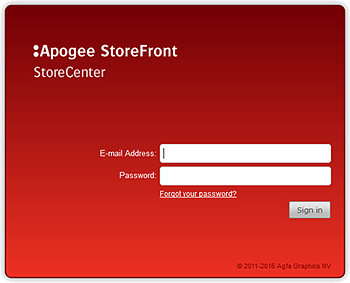
New company operator role
A new StoreCenter role is available: Company Operator. Admins who have this profile have the same rights as a printer operator but their actions are limited to the orders for the company they belong to and the stores that this company uses. This role has been added to facilitate the cooperation with third-party suppliers or sister companies.
Custom user attributes
Until now StoreFront used a fixed user profile to store data about shoppers. This profile included data such as the users first and last name, e-mail address, phone and fax number. Often it is practical to store additional data, such as a mobile number, personal billing code or department ID code. This is now possible through the use of custom user attributes. Such custom fields can be defined in the new Advanced > Custom User Attributes window. You can configure if users can see or edit these additional fields. They can also be made mandatory.

Each custom attribute can be given a unique code, which can be used by the Autofill function in the Online Editor to add the attribute to a customizable document. This means users can, for example, add their Twitter handle to their user profile and when they customize their business card in the Online Editor, that Twitter handle will automatically be inserted on the card.
Custom user attributes can be visible to users in the self-registration window and on their personal profile page. The attributes are also added to the Excel order summary reports as well as the exported JDF order data.
Access to the user license
The end user license agreement is now always accessible by clicking the hotlink in the top left corner of StoreCenter. This can be useful when customers, such as banks or governmental institutions, ask for a copy of the terms of service.
Integration
Resubmit jobs to Asanti
If a StoreFront order item is accidentally deleted in Asanti Production, you can now change its order status back to Prepared in StoreCenter. This means the workflow will once again download and process the order data.

Extended Excel order summary spreadsheet
The Excel order summary spreadsheet contains additional columns with the name of the billing company and their tax or VAT number.
Separate shipping cost handling
Apogee and Asanti workflow systems are capable of forwarding order item data to MIS or Management Information Systems. In this process the shipping cost is specified as part of the overall order value. Some MIS systems, however, expect the shipping costs to be specified separately as an additional order item. The MIS Export option can now do this to improve compatibility with MIS systems like Multipress from Dataline Solutions.

Post-update action items
Some of the changes and new features in this release require an intervention from a printer administrator:
| Action | Upgrade the StoreFront Converter extension on systems running Adobe InDesign CC 2015 |


 RSS
RSS
